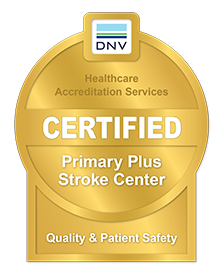Stroke Receiving Center at Saddleback Medical Center
If you have a medical emergency, please call 9-1-1.
Stroke is a Medical Emergency
If you think you or someone else is having a stroke, call 9-1-1 immediately and note the time of when any of the symptoms first appear. Do not drive yourself or wait for a ride from a friend or family member.
Saddleback Medical Center is certified as a Primary Plus Stroke Center through DNV Healthcare USA Inc. This certification confirms that we offer thrombectomy capabilities and the necessary staffing, infrastructure, and programs to stabilize and provide treatment to most stroke cases.
Know the Signs & Symptoms of Stroke with B.E. F.A.S.T.
Even though strokes are the leading cause of long-term adult disability and the number five killer in America, many people are not able to recognize the signs and symptoms when stroke strikes. People may also not realize that with a stroke, time lost is brain lost.
A stroke occurs when a vessel in the brain is blocked by a clot or ruptures. During a stroke blood flow is cut off, brain tissue is starved for oxygen and parts of the brain die. The more time that passes between when a stroke starts and a person receives treatment increases the chances for brain function to be permanently lost. This is why when a stroke strikes it is critical that the person experiencing symptoms receives medical attention and an accurate diagnosis fast.
MemorialCare Saddleback Medical Center encourages everyone to learn the signs and symptoms of stroke with B.E. F.A.S.T.
- B: Balance – sudden loss of balance and coordination
- E: Eyes – sudden trouble seeing or blurred vision
- F: Face drooping – face drooping on one side or numbness
- A: Arm or leg weakness – numbness especially on one side of the body
- S: Speech difficulty – sudden confusion, trouble speaking or understanding speech
- T: Time – stroke is a medical emergency, call 911 immediately and note the time of the first symptom
Recognizing the B.E. F.A.S.T. symptoms, calling 911 and noting the time of the first symptom can improve chances of stroke recovery and even save a life.
Ask your physician for tips on managing your current health conditions to reduce your risk for stroke. Take charge of your health, so you not only know how to reduce your risk, but can recognize the signs of stroke.
Programs
Providing 24/7 Expertise for Stroke Patients
Within approximately 15 minutes of arrival at Saddleback Medical Center’s Emergency Department, stroke patients have a board-certified neurologist at their bedside thanks to highly advanced technology. The patient and specialist, or tele-neurologist, can see and hear one another through high-definition video conferencing. Tele-neurologists can perform a complete examination and decide quickly on a course of treatment, 24 hours a day, just as if they were at the patient’s bedside.
Often, the first step in treating stroke is the administration of a clot-busting intravenous medication called tissue plasminogen activator (tPA). Typically administration must occur within three hours of symptom onset. When tPA is appropriate, stroke patients at Saddleback Medical Center receive the drug immediately. When given promptly, 1 in 3 patients who receive tPA resolve their symptoms or see major improvement.
However, for some stroke patients, tPA is not appropriate or is not enough, and a more complex surgical intervention is required to remove a clot or stop bleeding in the brain.
Saddleback Medical Center provides advanced treatment to stroke patients 24/7. We offer the most advanced, minimally invasive techniques using state-of-the-art technology. Since every minute counts, our advanced level of care is monumental because it helps save lives and minimizes disabilities.
Saddleback Medical Center has outstanding teams in the emergency department and biplane catheterization lab where stroke patients receive life-saving care. After patients have been treated, we have highly-skilled intensive care and rehabilitation teams that help patients recover.
Saddleback Medical Center is part of the “Get with the Guidelines—Stroke” program from the American Stroke Association to provide the most current and effective procedures to improve the overall quality of care for first-time stroke patients and treatments for those who have a history of stroke. The program employs proven, evidence-based treatment guidelines—including those developed by the American Stroke Association, American Heart Association and Brain Attack Coalition.
The American Heart Association and American Stroke Association recognize Saddleback Medical Center for achieving 85% or higher adherence to all Get With The Guidelines® Stroke Performance Achievement indicators for consecutive 12 month intervals and 75% or higher compliance on at least 5 of the Get With The Guidelines Stroke Quality Measures to improve quality of patient care and outcomes.
Resources
Advancing Research Forward
At MemorialCare, research is woven throughout national consortiums and centers of excellence through clinical trials and novel investigations to improve population health – effectively safeguarding the community by improving outcomes, while lowering costs for patients.
Conditions
3 Total Results
Providers
Find a Provider Near You
Located throughout Orange County and Los Angeles County, MemorialCare-affiliated physicians are locally and nationally recognized in their area of expertise. We've made it easy to find a quality healthcare provider right in your own backyard.